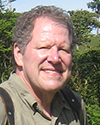 William I. Woods |
2013 Rip Rapp Archaeological Geology Award
Presented to William I. Woods
Citation by William Doolittle
The Geological Society of America presents its 2013 Rip Rapp Archaeological Geology Award to William I. Woods. Over the course of four decades “Bill,” as he is known to friends and colleagues, amassed a record of distinguished research that not only blurs the line between geology and archaeology, but between soil science and geomorphology, and geography and anthropology. And, he has done so on three continents.
He began his career as a student in Wisconsin studying climate-soil associations, moved on to Germany where he studied chemical analyses of soils on medieval archaeological sites, and then returned to the US to establish his career. Exactly where, when, and how Bill transformed from a student to a professional is as unclear as the boundaries of the disciplines he transcends. Suffice it to say his work is both multi- and inter-disciplinary.
Bill has made significant contributions in earth science and archaeology working for years at Cahokia in the Midwest, with an eye toward understanding environmental dynamics as evident in the flooding and sedimentation sequences, deforestation, and agriculture. At the Amalucan site in Mexico he unraveled the nuances of a complex ancient water control system buried under more than a meter of sediment. His work in the Maya Mountains of Belize involved assessment of soils and geomorphology in areas of terraced agriculture, and his geoarchaeological research in Belgium contributed to understanding motte-and-bailey sites.
For the past 20 years, Bill has been involved in research on terras pretas, or dark earths of Amazonia. Working with scholars from the Brazil, Europe, and the US, he was instrumental in discovering that these soils are anthropogenic, and living—regenerating themselves. And, as they had sustained large populations in times past, they are capable of sustaining large populations today. Because of Bill, geology through archaeology now has a direct bearing on future agricultural and economic development.
The author of seven books, more than 120 articles and chapters in geological and archaeological journals, and countless site reports, William I. Woods is a most worthy recipient of the Rip Rapp Award.
 2013 George (Rip) Rapp Archaeological Geology Award — Response by William I. Woods
2013 George (Rip) Rapp Archaeological Geology Award — Response by William I. Woods
From Troy to Minnesota and many points in between George “Rip” Rapp, Jr. has for decades been at the forefront of geoarchaeological research. His many contributions have literally transformed geoarchaeology from a seldom employed novelty to an essential component of all thorough archaeological investigations. I certainly was familiar with Rip’s work, but did not have the opportunity to meet him until the 1986 Penrose Conference on Archaeological Geology. A total of 57 of us met on St. Simon’s Island for five days in December. Rip’s boundless energy and encyclopedic familiarity with all of the many topics presented in the papers and discussions that occurred during our fieldtrips was essential to the success of the conference.
To be a part of this group was essential for my professional and personal development and I was most pleased when Norm Herz nominated me for membership in the GSA. I immediately jumped at the chance and have reaped the benefits of this relationship many times over. I did not ever expect though that I would be chosen to receive the Geological Society of America’s 2013 Rip Rapp Archaeological Geology Award. Thank you Rip and all those who supported me for consideration for this most prestigious award.
I am both most honored and quite humbled by becoming a member of such an august group of recipients. None of us can truly say that we have made our advances on our own though. Mentors, colleagues, and friends and family have contributed immensely to my career achievements and my deepest appreciation is extended to all of you. Please excuse me for not mentioning you all by name, but know that I have not forgotten your contributions and you are in my heart.
It has been a great road to travel. I have been most fortunate to be able to pursue a profession I love, get funding for interesting projects, work with a marvelous group of fellow scholars, and continue to engage in new experiences and to learn. Thank you, my fellow geoarchaeologists for making this life possible.
